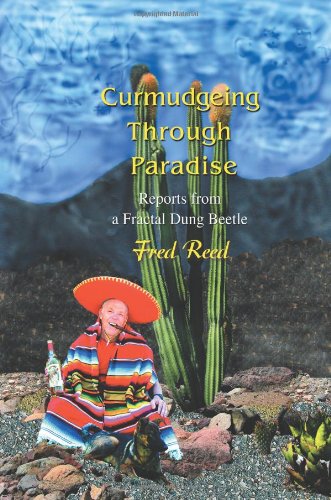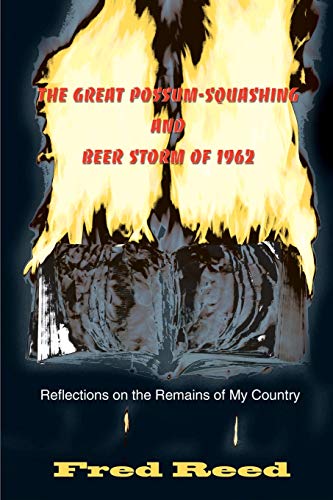
Race riot in the South, 1863. Wikipedia: “Rioters subjected black men to the most brutal violence: torture, hanging, and burning.” Eleven were lynched. The Southern mob depicted here were afraid that if the North won the Civil War, freed slaves would take the jobs of whites.
Virginian though I am, a son of the Shenandoah, and brought up among the lazy rivers of the state of Marse Bob Lee and Stonewall—rivers where the sun always seemed to shine and you could mostly catch catfish, and almost think that being alive was a good thing until further experience intervened—I have to admit the deep vileness in the Southern soul. Yes. It was this that brought forth such scenes as above. I cannot deny that the events portrayed happened in the South.
 Au Phuc Dup and Nowher...
Best Price: $6.95
Buy New $10.95
(as of 08:20 UTC - Details)
Au Phuc Dup and Nowher...
Best Price: $6.95
Buy New $10.95
(as of 08:20 UTC - Details)
The south of Manhattan, anyway, the drawing being of the race riots of 1863 in New York, in which Yankee mobs killed 115 or so innocent people, many of them black.
Here was early evidence of the deep regard in which Yankees held black men—and still hold them if you look at actions and not protestations. There is nothing like a damn Yank to tell how good he is, how drowning in the curds and cream of human kindness, without in his actions displaying a trace of it.
But should we be surprised? These were the same blue-coats who exterminated the Indians. “The only good Indian,” said the Yankee general Sherman, “is a dead Indian.” Such charitable musings were not unique to him. It was a Yankee named Custer, if memory serves, who after the war devoted himself in the name of the Yankee government to killing Indians, though with mixed results. Yet another Yankee general, Phil Sheridan, wanted to slaughter the western buffalo to starve the Indians to death. I cannot withold my admiration for Northerners for the consistency of their racial philosopy.
Do not misunderstand me. I do not mean to imply that Northerners are the world’s mother lode of preening fraud and practiced hypocrisy. I mean to state it. To talk to these geysers of virtue, you would be sure that their principal object in life was to help the black man, to admit him to the human race as an equal and a brother. I imagine them waking up in the middle of the night thinking how they might advance their darker brethren. Most of them likely do not get enough sleep because of it.
Yet I confess a desire for confirmation. I want to say to them, “Yea, verily. And when was the last time you had black friends to dinner?”
 A Brass Pole in Bangko...
Best Price: $3.94
Buy New $18.80
(as of 01:20 UTC - Details)
A Brass Pole in Bangko...
Best Price: $3.94
Buy New $18.80
(as of 01:20 UTC - Details)
Or even, “And while we are thinking of your deep wells of goodness, those crystalline pools of measureless depth—when was the last time you dined in a restaurant where the majority of the patrons were black…ummm?”
As I thought.
I remember years back that the Washingtonian, the suburban coffee-table magazine of the Yankee Capital, surveyed the news room of the Washington Post, that epicenter of racial oneness, of inattention to color, to see how many of the white reporters sent their children to the black public schools of Washington. “All of them,” I hear you say. “Such paladins of brotherhood could do nothing else.”
Zero. Not one child in a black school. The minute the wife knew that she was pregnant, the couple moved to Montgomery County, Maryland. But no, no! Not because of race! Perish forefend. It was because, well…the shopping was better. Yes, that was it. The shopping.
But perhaps the best way to compare the dark night of the Southern soul with the supernal radiance to the north is to compare the schools the two regions provide for their freed slaves. One would expect schools in the South to be poor, and they are. But in the North, surely the schools are of a high order, well regulated, producing through their lofty academic standards black graduates scoring high on the SATs and not needing the humiliations of affirmative action.
 Curmudgeing Through Pa...
Best Price: $2.50
Buy New $17.73
(as of 01:45 UTC - Details)
Curmudgeing Through Pa...
Best Price: $2.50
Buy New $17.73
(as of 01:45 UTC - Details)
Surely this is what we will see. Otherwise we would have to concede that, 150 years after the Civil War, the North is still holding black children in illiteracy and squalor. Then, Lord save us, we might doubt the purity of Northern intentions.
Fear not! Nothing can be more admirable that the black schools of such northern precincts as, say, Newark, Trenton, Camden, New York, Philadelphia, Detroit, Cincinnati, Flint, Gary, St. Louis, Pittsburgh, Baltimore, Chicago, and Washington—schools in the very intestines of Yankeedom. Why, one can hardly tell them from Groton. They display for all to see the superior morals of the North.
They do indeed.
Yanks love to talk about slavery, which they say was horrible and inexcusable. It was. This is today like blaming Jews for killing Christ (“Gosh, Rachel, you don’t look old enough.”) But logic confuses Yanks, so I will not essay it. Anyway, slavery existed because in economic terms it was well suited to plantations, and accomplished the enrichment of greedy men of negligible decency—which is to say, businessmen.
For horrible, try Journal of a Residence on a Georgian Plantation – 1838-1839
But slavery was ill-suited to an industrial state. It lacked flexibility. You had to feed and maintain slaves whether business was up or down. They were a burden and a responsibility. Kindly Yankees hit upon the superior idea of sweated labor, usually of immigrants who had no way of defending themselves. These could be fired when convenient. If they then died it was a matter of no account as, the Lord be praised, more were arriving by the boatload.
And so the pious men of Northern money, who went to church every week, learned to work children twelve hours a day in tubercular dimness, where they grew deformed from poor diet and died early of lead poisoning and rickets.(Try How the Other Half Lives: A Jacob Riis Classic (Including Photography)

Immigrant children in New York, cared for with humanity and love.
Of course this wholesome system sometimes resulted in unfortunate revelations. If to save a few dollars the master of a noisesome tenement neglected to install fire escapes, and in the ensuing conflagration girls were clutching each other and jumping to their deaths from the seventh floor to avoid being burned to death—ah, well. The ways of God were mysterious, and girls easily replaced.
There was no slavery, though. That would have been immoral.

Halloween in New York. The children are disguised as malnourished slum kids with no schools, while their pet horse naps.
After the Civil War, Yankees continued, as they do today, their encouragement of integration for everyone else. Yankees are always sure of what someone else ought to do. Since most blacks were
 The Great Possum-Squas...
Best Price: $7.67
Buy New $11.66
(as of 01:55 UTC - Details)
in the South, it was safe to be for racial amity as the North would not have to practice it. When blacks migrated north, the Yanks contained them in poor parts of the cities, as they do today (consult the list of cities foregoing). There were occasional adventures such as the Harlem Renaissance, when fashionable Northerners could go to the Cotton Club and mingle, barely, with real blacks. “Why, they are just like people, almost. Look at them dance!” Uptown, they might keep a few trained and gelded blacks around as ornaments. That was the extent of it.
The Great Possum-Squas...
Best Price: $7.67
Buy New $11.66
(as of 01:55 UTC - Details)
in the South, it was safe to be for racial amity as the North would not have to practice it. When blacks migrated north, the Yanks contained them in poor parts of the cities, as they do today (consult the list of cities foregoing). There were occasional adventures such as the Harlem Renaissance, when fashionable Northerners could go to the Cotton Club and mingle, barely, with real blacks. “Why, they are just like people, almost. Look at them dance!” Uptown, they might keep a few trained and gelded blacks around as ornaments. That was the extent of it.
Is this not what one would expect, in the light of the Yankee’s firm belief that blacks are an inferior strain, half devil and half child, bearing the mark of Ham and incapable of the higher forms of civilization? No, Yanks do not say this, but their every action gives the game away. Always they lower the standard for the black man, but never try to raise the black man to the standard. Why? Because they do not believe that blacks can reach the standards of whites. What is “affirmative action” but the belief that a black cannot perform at the white man’s level? Sometimes they talk of “the tyranny of low expectations.” Indeed. But who in Newark holds those low expectations?
Southerners, I reckon.
Forgive me. I do not mean to offend residents of the North, where virtue runs in the streets until it clogs the storm drains, and the low-hanging branches of trees are damaged by the halos of pedestrians.




